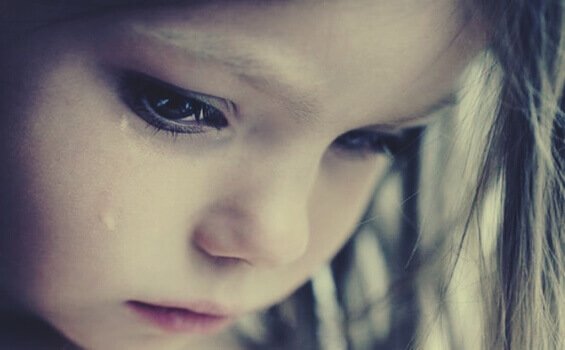Emotional Attachment and the Fear of Abandonment

Feeling safe and secure in all areas of our lives is essential in order to experience well-being. However the greatest need for this is in our relationships. If there is security, then we will feel trust and protection. If, however, these feelings are threatened by the ghosts of the past, then fears will invade our lives. One of the greatest of these is the fear of abandonment.
The insecurity that the fear of being abandoned causes can undermine a relationship. This is especially true when the origin of it all is a broken and suppressed childhood. Whoever harbors this obsessive fear can unintentionally harm their relationship and cause his partner to confirm what he already suspected. On the other hand, the relationship can become so destructive that both members trap themselves in a spiral of discomfort and suffering.
Being afraid from time to time that the relationship isn’t working is quite normal. However, living in a continuous situation of distrust and hypersensitivity to rejection only causes discomfort and instability. Let’s have a more in-depth look at what the fear of being abandoned implies.
The importance of the bond of attachment
During the first year of life we establish an emotional bond with our main caregiver, which is known as attachment. Through this relationship and the type of bond we build, each one of us will acquire a series of emotional capacities. We will apply these in our future interpersonal relationships.
If that link never happens, then this will cause great problems in the future. If this is the case then our physical and emotional needs may have conditioned us to grow up feeling unprotected, insecure and distrustful. This is one of the consequences that are explained in Bowlby’s theory of attachment (see below). He explains the deep sense of abandonment that many people experience, even though they are surrounded by their loved ones. Let’s look at an example to try and understand it better.

The hungry baby
A baby is feeling hungry because it hasn’t eaten for several hours. His whole body is telling him that he is hungry. However, the only tools he has at his disposition are crying and agitation. His mother, as the main carer in this case, captures the signals he is emitting and interprets that he is hungry. Why? Because she has learned to detect her baby’s physical and emotional needs and to aliviate them. This will restore the baby’s physiological and emotional balance.
When the baby lives through these types of experiences continually, then it will always look for physical proximity with its mother. He trusts her to be able to calm him and regain his balance. Later in their development, the child will be able to endure upsetting experiences just by seeing his mother approach him or say “I’ll be back soon”.
Because of this, when something similar happens to you when you are an adult, you keep calm. You know that in a few hours you’ll see your relative, partner or friend. Your brain has learned that it can feel calm and that this can be a permanent sensation.
If the infant brain has never experienced that sense of calm or the belief that after a bad experience you can experience peace, then the adult brain won’t either. You won’t feel confident in an intimate relationship because you haven’t learnt where to find calmness.
In addition, the absence of contact and lack of care results in a higher production of adrenaline in the brain. This predisposes us to more aggressive and impulsive behavior. It also makes it difficult for us to control our emotions.
The emotional wounds of abandonment in couples
As we can see, there are wounds, like the feeling of abandonment, that, although we don’t see them, lurk in the deepest part of us. They are capable of conditioning so many parts of our lives. Many situations we experience in childhood leave their mark on us. If untreated, they are capable of tearing us up inside, without us even realizing it.
Bowlby, in his attachment theory, established that emotional ties formed in childhood continue in the form of models in the representational world of the adult. Hazan and Shave also confirm this fact in their investigations. They showed that adult behavior in relationships shapes itself with the help of the mental perceptions which originated in the relationship between the child and their parents.
In this way we can see that the fear of abandonment in relationships has its roots in childhood. They are the ghosts of the past that return, bringing with them all our insecurities. They try to remind you that you aren’t worthy to receive love or good treatment from other people. They usually appear because the brain receives an alarm signal.
Emotional attachment
A word, a place, a type of behavior or memories are enough to activate an “emergency situation” in a person who was never able to feel completely safe or secure. From there, a whole avalanche of emotions and conduct start to show themselves. Instability, apathy, sadness, to name but three.

Besides that, the person who experiences the fear of abandonment usually develops emotional dependence towards their partner. They end up needing their constant approval. If their relationship is a toxic one, then they will be completely unable to end it or distance themselves. It’s as if it they were nothing without the other person. They are capable of doing absolutely anything to keep the relationship going. Everything, that is, except reopening old wounds.
In some cases, this fear of abandonment generates a kind of addiction to this lack of worth and self-deprecation. As they don’t feel wanted or secure, they need to confirm that this identity is still there. That’s why, if they do actually find protection and security, they ends up rejecting or not believing it. All of this is caused by deep seated traces of an untreated post-traumatic stress.
The fear of abandonment
The fear of abandonment is a very deep emotional wound, rooted in childhood. Healing this wound involves accepting and forgiving the past in order to let it go. It’s a complex task. Especially if the person is not aware of how they have been conditioned by their previous experiences. This is often worsened by their defenses. What should have been for their protection, turns out to be not so impervious after all.
In fact, in the most complex cases it is advisable to go to a professional. They will be able to help you, especially in the first important steps. Another aspect that has to be worked on is self-esteem. It is usually cracked, even broken. Learning to value yourself is essential to break the trap of emotional dependence. In addition, with good self-esteem it will be much easier to manage the emotions and thoughts that are anchored in your past experiences.
Changing our emotions
Emotions such as anger, resentment, fear or sadness are very common in people who are afraid of being abandoned. You need to learn to reduce their intensity and to decipher what they really mean. When you do this, you’ll be able to change them into something positive.
Negative assumptions and expectations are also elements that must be taken into account. Most of the time our thoughts are what influence and heighten our fears. They make them far bigger than they should be. If we are afraid our partner will leave us, we will be more conscious of their behavior and words. We will often misinterpret them to confirm the fears inside us.

As we can see, healing the fear of abandonment involves a process of rebuilding. This is a process that requires time. We need to learn to prioritize and uncover our fears. There is something we mustn’t forget. On many occasions, what we think is happening on the outside is nothing more than a projection of what is happening inside of us. If you can identify with any of these symptoms then we encourage you to find help and healing before it’s too late.
All cited sources were thoroughly reviewed by our team to ensure their quality, reliability, currency, and validity. The bibliography of this article was considered reliable and of academic or scientific accuracy.
- Zerubavel, N., Messman-Moore, T. L., DiLillo, D., & Gratz, K. L. (2018). Childhood Sexual Abuse and Fear of Abandonment Moderate the Relation of Intimate Partner Violence to Severity of Dissociation. Journal of Trauma and Dissociation. https://doi.org/10.1080/15299732.2017.1289491
- Franzblau, S. H. (1999). Attachment Theory. Feminism & Psychology. https://doi.org/10.1177/0959353599009001001
This text is provided for informational purposes only and does not replace consultation with a professional. If in doubt, consult your specialist.








